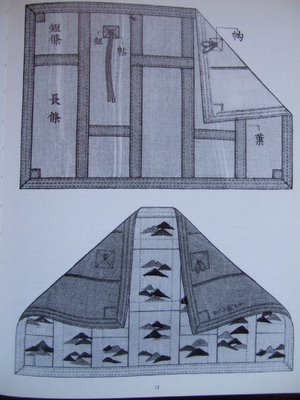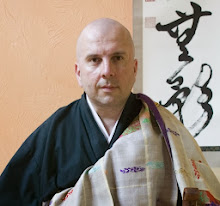
1980. I was seventeen at the time. There was a Zen Temple in Valenciennes where I used to go once a month to sit with the monk, Francis, a solid, down to earth guy. I remember collecting three sheets of paper with very basic and rough drawings and instructions. I really wanted to sew a kesa and knew nothing about sewing. It all really started one Saturday afternoon, after Zazen, we turned round facing the altar for a bit of chanting and there it was, a nun called Antoinette, sitting all wrapped in a beautiful and yet so simple kesa. She was radiating in spite of everything, in spite of herself. From that day on, I had it in my mind everyday: I had to sew that thing.
So one morning, I go to a shop to get some fabric with no idea of what I could/should buy. And I end up with the thickest kind of coarse cotton and a thread that has almost a string quality to it. And I get started. Cutting the rough cotton, nothing straight, bad scissors and inexperienced sewer, day after day, night after night, stitch after stitch, the robe comes true in my hands. What a mess! Nothing is right about it, the proportions, yo, frames…and the stitches, rather knot looking when I compare them to the impeccable and beautiful kesa sewn by skilled hands. A true robe of rags. I bring it along to a senior monk who looks unimpressed…he shows me how to put it on and take it off.
I still remember it, the day before I receive Shukke, a nun comes to me and ask: “Have you beeen shown how to sew properly? Who taught you how to sew the frame?” I look pretty confused and answer something stupid like:”I didn’t know… sorry… I am self taught… I did my best”. She walks away apparently quite happy with my shy mumbling.
This kesa is the true kesa. Full of imperfections. Full of mistakes. I made a mess of it. I make a mess of my life too. I studied closely Kodo Sawaki’s kesa and sewing style, it is wonderfully clumsy . Even if with time I got more skilled I now understand that beautiful or not, skilful or not, right or wrong…are but flowers in the eyes.
The point is to sew, with all your heart and being. To drop your views and come back to it, as you come back at every stitch with your needle and thread.
If you really want to understand what the kesa means, then get down your high chair, leave the house made of solid thoughts and beliefs, allow a deep breath, play with clouds and enjoy your mistakes. It’s always a good start.



1 Comments:
Thank you, Pierre. If the kesa had never taught you how to not worry about mistakes, however could you have been open to the teaching of a bumbling fool?
Post a Comment
<< Home